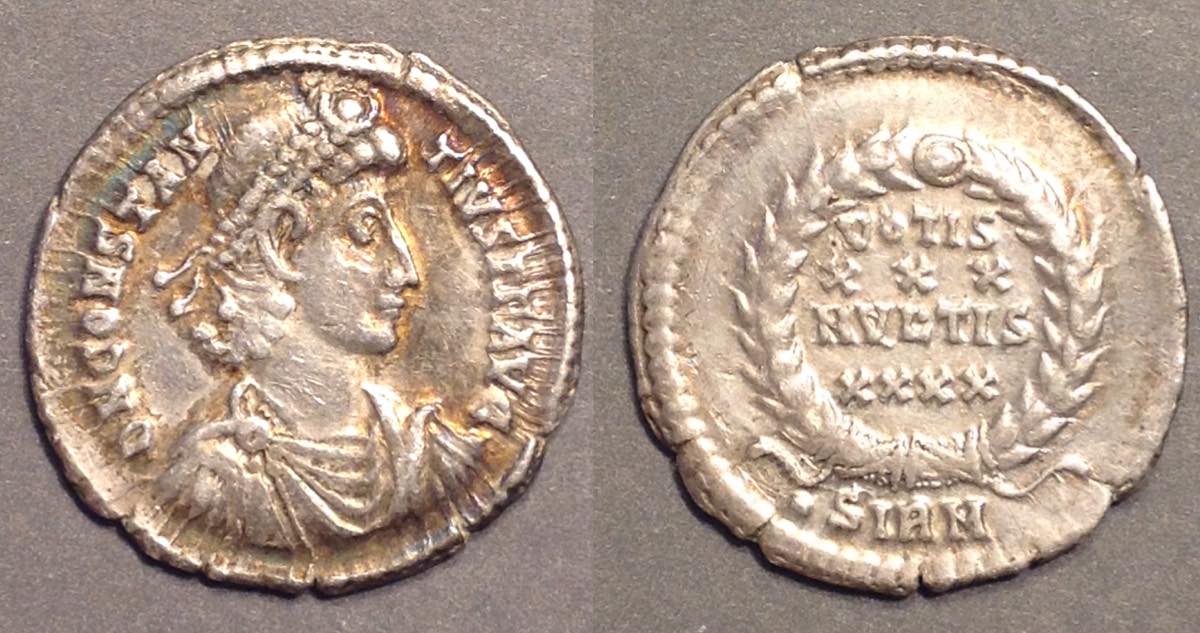 The siliqua Roman coin denomination in the fourth century AD.
The siliqua Roman coin denomination in the fourth century AD.
To the right: A siliqua of emperor Constantius II (337-361) struck c. 353 AD.
Silver. 21.5 mm. 2.90 grams. (The diameter of a US nickel, but thinner.)
Obverse: Bust of Constantius II right, draped, cuirassed, and pearl-diademed.
Reverse: VOTIS/XXX/MVLTIS/XXXX in a wreath, with mint mark
(Vows for 30 years of reign, multiplied for 40 years)
• SIRM for Sirmium (now in Serbia).
RIC Sirmium 17, struck Sept. 351 - Nov. 6, 355. (References are at the end.)
What's new? 2022, Jan. 22: Siliqua of Arcadius.
This is the most common reverse design on siliquae (the plural of siliqua). This same design comes in two distinct sizes. This example is of the earlier size which is usually about 21 mm and 3 grams. The later "reduced" size (introduced in 355) is smaller, only 19 mm and about 2 grams. [All image sizes are proportional.]
Two "reduced" siliquae of Constantius II as Augustus 337-361
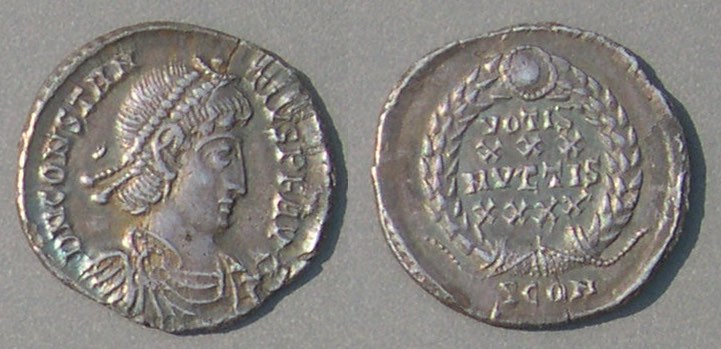 |
 |
| Constantius II, struck 355-360 |
Constantius II, struck 355-360 |
18 mm. 2.03 grams. A "reduced siliqua."
Note it has the same design as the larger unreduced siliqua,
but has much less silver (2 grams compared to 3 grams).
VOTIS XXX MVLTIS XXXX
SCON for Constantina = Arles. RIC Arles 207 |
17 mm. 1.96 grams. A "reduced siliqua."
VICTORIA DD NN AVG
Victory standing left holding wreath and palm
LVG for Lugdunum = Lyons. RIC Lyons 214 |
Reduced siliquae of c. 2 grams (theoretically 2.2 grams, but they are usually lighter) are more common than full-weight "pre-reform" siliquae of c. 3 grams. Siliquae that weigh less than 1.9 grams may be "clipped" as discussed below.
Below there are more photos that illustrate the next paragraphs of the introduction and they are followed by many more photos arranged in chronological order by emperor below.
Roman Silver Coinage. The role of silver coinage in the fourth century is far more complicated than in earlier centuries. There are several silver denominations of which the siliqua is the most common. Constantine introduced a silver denomination we call a siliqua (and other silver denominations) but it is very rare and weighs more than the later siliquae. Silver coins issued in the names of his sons before and after his death in 337 are lighter and include the denomination we call a siliqua (c. 3 grams) and other, rarer, denominations including the larger miliarensis which comes in both "heavy" and "light" sizes (apparently in circulation simultaneously) and various "multiple" denominations (such as "small medallions" and 4-siliqua pieces).
Constantius II reduced the weights in 355 (about the time when Julian II became Caesar) and the most common siliquae are "reduced" siliquae (c. 2 grams) from after that reduction. However, rarer coins of very similar types but c. 3 grams (the previous unreduced weight) were occasionally still issued under Valentinian and later (The two different weights must have been confusing). The denomination of the later coins with earlier weights is sometimes called a "pre-reform siliqua" (even though they are issued post-reform) and sometimes called an "argenteus" (the same name given to the silver coin under Diocletian and his co-rulers which had a similar weight, but had been discontinued 50 years before). The reasons for this perplexing complexity of weights are a matter of speculation. A major reference is Roman Silver Coins and their Values, Volume V, by Cathy King, which lists and discusses all the silver types of the fourth century. Nevertheless, a lot remains unknown about them. The volumes of RIC provide date ranges and rarity ratings for each type. Most are in Volumes VIII (before Valentinian) and IX (Valentinian through Theodosius).
Siliquae of Julian II, Caesar 355-360 and Augustus 360-363
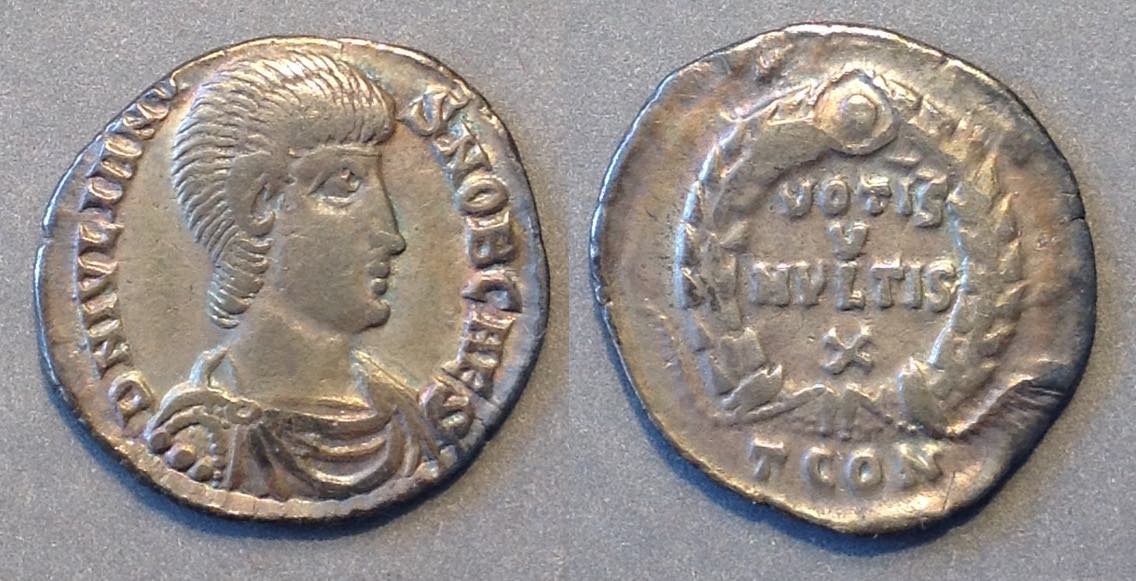 |
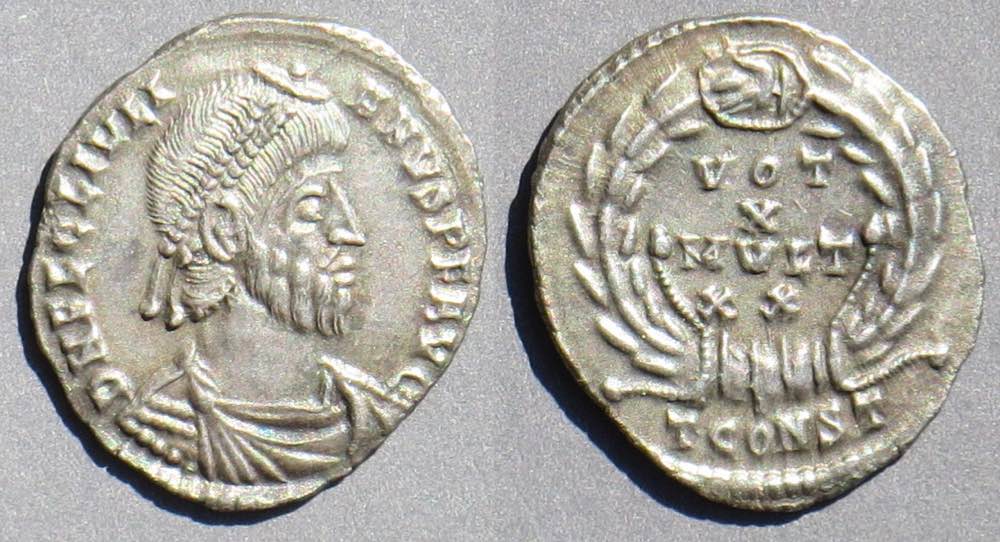 |
| Julian II, as Caesar. Struck 355-360 |
Julian II, as Augustus. Struck 360-363 |
17 mm. 1.95 grams
VOTIS/V/MVLTIS/X in wreath
TCON for Constantina = Arles. RIC Arles 264. |
18-16 mm. 2.14 grams
VOT/X/MVLT/XX
TCONST for Constantina = Arles. RIC Arles 309 |
Siliquae were issued for all the following emperors, including Jovian, 363-364, and his successors.
Siliquae of Valentinian, 364-375, and Valens, 364-378
 |
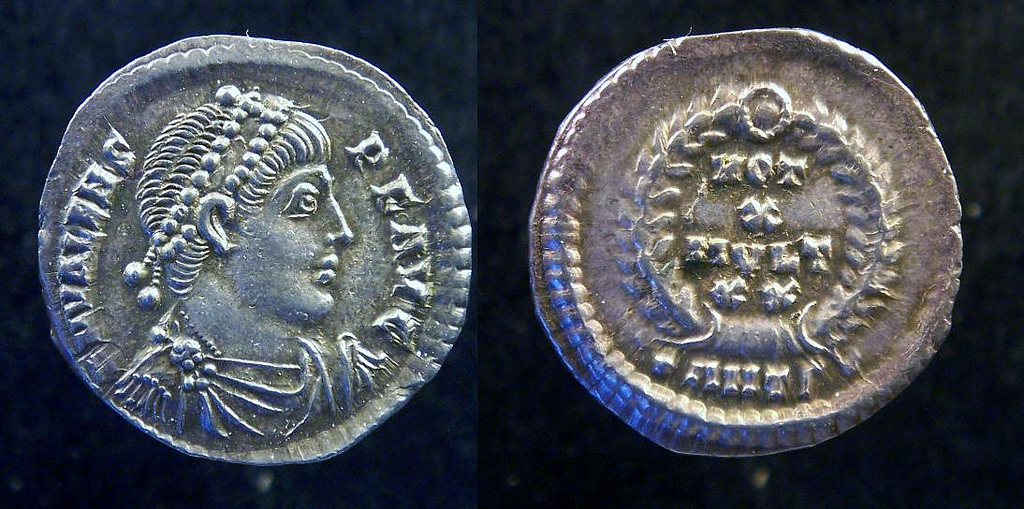 |
| Valentinian I, struck 364-367 |
Valens, struck 367-375 |
19 mm. 1.91 grams. Siliqua.
DN VALENTINIANVS PF AVG
VOT X
CP • Δ for Constantinople. RIC Constantinople 13a |
19-18 mm. 2.05 grams.
DN VALENS PF AVG
VOT/X/MVLT/XX in wreath
•ANTΓ• in exergue. RIC Antioch 33c. |
By the time of Valentinian, the word "siliqua" refers to coins of the weight of the previous "reduced" siliqua, so there is no need to attach the word "reduced" to his 2-gram coins. Some coins with the same design of the Valentinian above weigh close to 3.0 grams, the old weight of the unreduced siliqua. Has this example been clipped so much that it lost more than a gram of silver? It doesn't look like it. It is just a siliqua.
For many more examples, including emperors omitted in the introduction here, see far below.
Clipped coins. Many siliqua found in hoards with fifth-century closing dates have been clipped, that is, silver has been sheared off the edges. One reason for clipping would be to profit from the silver shavings and hope that the clipped coin passes for full value anyway. But, there are other explanations. Cathy King noted [Preston Hoard, p 55] that the weights of clipped coins seem to cluster around specific weights which might mean that, over time, there was more than one new weight standard. Also, "No British hoard ending before Arcadius and Honorius seems to have clipped coins in it" [p. 49]. Therefore, older coins would either be removed from circulation and saved (according to Gresham's Law) or, to remain in circulation, they were shaved down to the lower weight-standard current at the time. Nevertheless, many are clipped to weights significantly below the weights of any official issues. They must have been valued by weight, not by denomination. Peter Guest, who wrote the book on the Hoxne Treasure, proposed "that clipping took place in Britain in order to provide a source of silver to produce the provincial [British] imitations," which were usually "struck with locally-made dies and using silver of the same fineness as the regular coins." That is, they were not deceptive, just lighter and expected to be so.
An original and a clipped siliqua of Valens, 364-378
 |
 |
| Valens, struck 367-375 |
Valens. Struck 375-378. Clipped later. |
18 mm. 2.21 grams. Siliqua.
DN VALENS PF AVG
VRBS ROMA
Roma seated left holding Victory on globe
TRPS• for Trier. RIC Trier 27e |
Now 15 mm and 1.43 grams.
Originally this was the same as the type to the left,
which was 18 mm and 2.21 grams, but this one is clipped.
VRBS ROMA
TRPS for Trier. RIC Trier 27e |
Clipped siliquae always preserve the imperial portrait. The next clipped example has most of the legend gone, but the portrait is still there.
Siliquae of Honorius, 393-423. One not clipped and one clipped
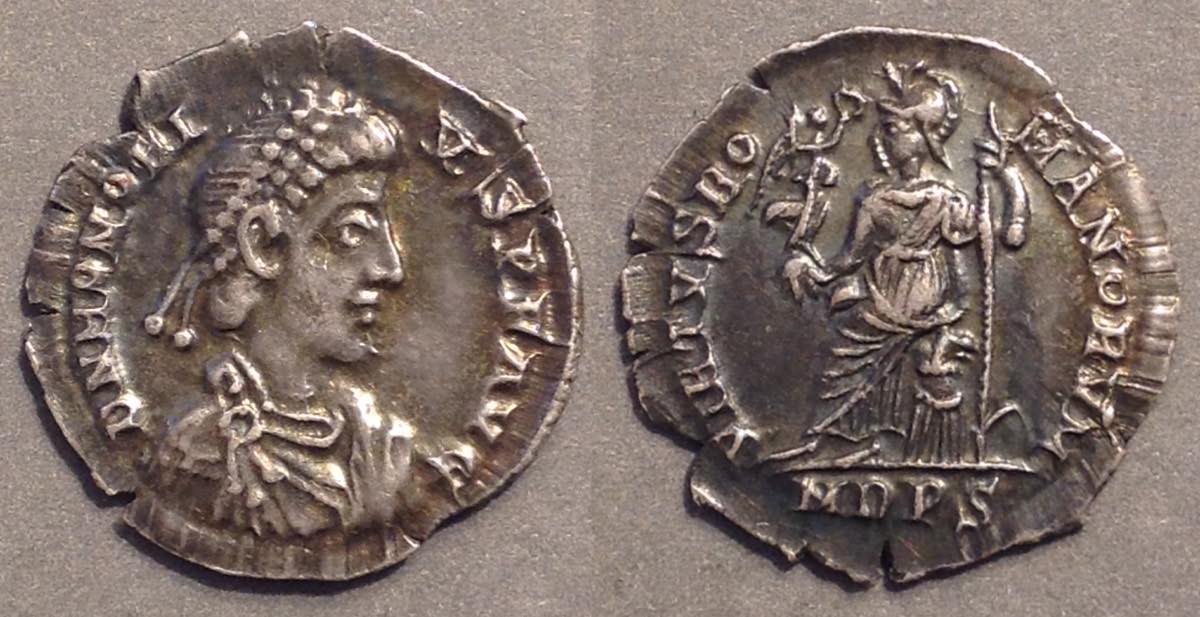 |
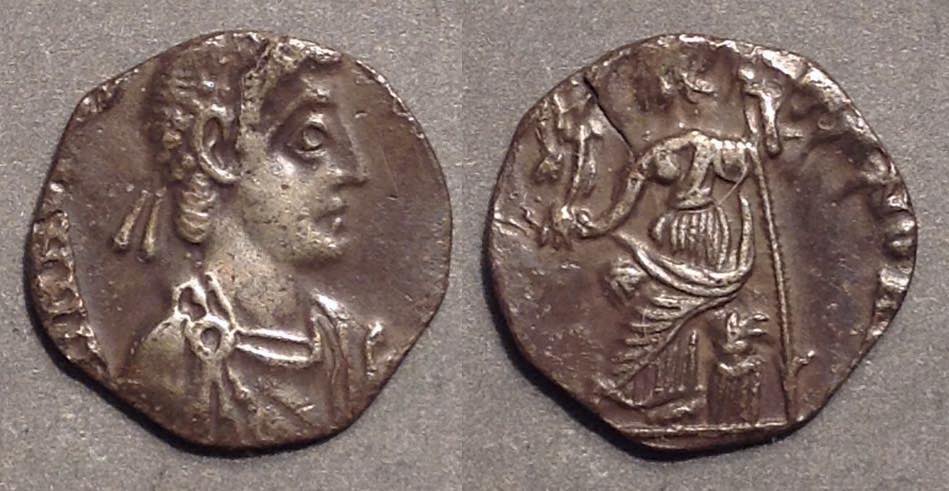 |
| Honorius, struck 395-402 |
Honorius, struck 395-402 |
18 mm. 1.09 grams. (Light and thin!)
VIRTVS ROMANORVM, Roma seated left on cuirass
holding Victory on a globe and a reversed spear
MDPS for Milan. RIC X Milan 1228c |
13 mm. 0.73 grams.
The same type, but clipped!
Fortunately, the "HO" at 9:00 can be seen
so we can identify the emperor.
Mint mark off the flan. |
Some silver coins of Honorius adhere to the 2-gram standard, but those from later in his reign are lighter (see the full-flan coin above which is only 1.09 grams. Maybe it is a unusually well-done half siliqua?). In the early fifth century the weight standard was 1.5 grams or less (King, Preston Hoard, p. 55). It is not easy to say what a late Roman siliqua "should" weigh. There was a weight reduction at Milan (but not Trier) in 388 and a weight reduction in 395 (Ball), which comlicate matters.
 To the right is a plate of clipped siliquae from the Preston Hoard. 385 of its 388 coins were clipped. (Clicking on it will enlarge it.) In the massive Hoxne Treasure 98.5% of the 14,565 siliqua were clipped [Guest, page 8].
To the right is a plate of clipped siliquae from the Preston Hoard. 385 of its 388 coins were clipped. (Clicking on it will enlarge it.) In the massive Hoxne Treasure 98.5% of the 14,565 siliqua were clipped [Guest, page 8].
In England, quite a few "fingernail hoards" have been found which consist of bulk clippings, not yet melted.
Comment for collectors. A substantial fraction of extant siliquae have been clipped which means very many siliquae offered on the market have been clipped. If you want a full-flan original, you must be attentive to the possibility a few tenths of a gram have been shaved off the edges. It would help if weights had been regular and precise (like they were for gold). Then we could say, "It should be of such-and-such a weight, so coins weighing less than that have been clipped." But almost all sources, including King and RIC, do not say what the weights of the various issues should be. It can be obvious a coin has been clipped (as with the clipped examples above), but it can also be not so obvious. Then you must look closely at any offered coin and decide for yourself it it has been clipped. Consider the Valentinian example above. That coin weighs less than 2 grams. Was it clipped down? Or, is it unclipped but randomly lighter? Look closely at it and on the reverse from 10:00 to 3:00 it looks like it might have been clipped a bit, but not much. If clipping bothers you, be sure to factor it in when you price a coin.
Imitations. In the Hoxne hoard there were 428 siliqua "copies" locally produced that were "metallurgically indistinguishable from official coins." They were good silver and apparently not produced for profit, rather to increase the supply of coins in circulation. "New copies would appear soon after any decrease in the supply of new siliquae into circulation" [Guest, p. 8]. In other words, these imitations were readily accepted for local use. Only "a handful" were forgeries with far less silver than official coins. Siliquae are thin so it is harder to make profitable fourré counterfeits. Nevertheless, they exist.
Ancient forgery of a siliqua of Julian II
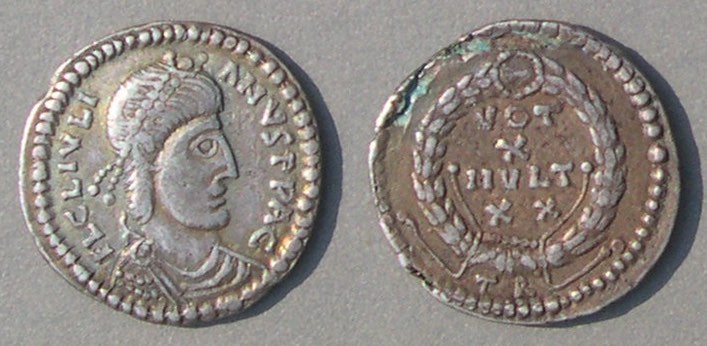 |
| Julian II as Augustus. 360-363 |
18 mm. 2.05 grams.
FL CL IVLI_ANVS PP AC
VOT/X/MVLT/XX in wreath
TR in exergue. No exact prototype in RIC, which has
VOTIS/X/MVLTIS/XX from Trier (#363-365) and
VOT/X/MVLT/XX from Lugdunum (#231-235).
Arles 309-311 have this legend with Julian sporting a long wavy beard as seen above. |
The style makes it clear this is a copy and the break near the rim at 10:00 - 12:00 on the reverse shows it is a fourré counterfeit.
The siliqua weight standard had been about 2 grams from 355 until Arcadius and Honorius, but the standard declined in their reigns (to about 1.6 grams, but many are clipped to less) and in the fifth century and many fourth-century siliquae from fifth-century hoards are clipped. Next is a full-flan fifth-century siliqua on a standard of c. 1.6 grams, less than the previous 2-gram standard.
Theodosius II, 402-450. A siliqua and a miliarensis.
 |
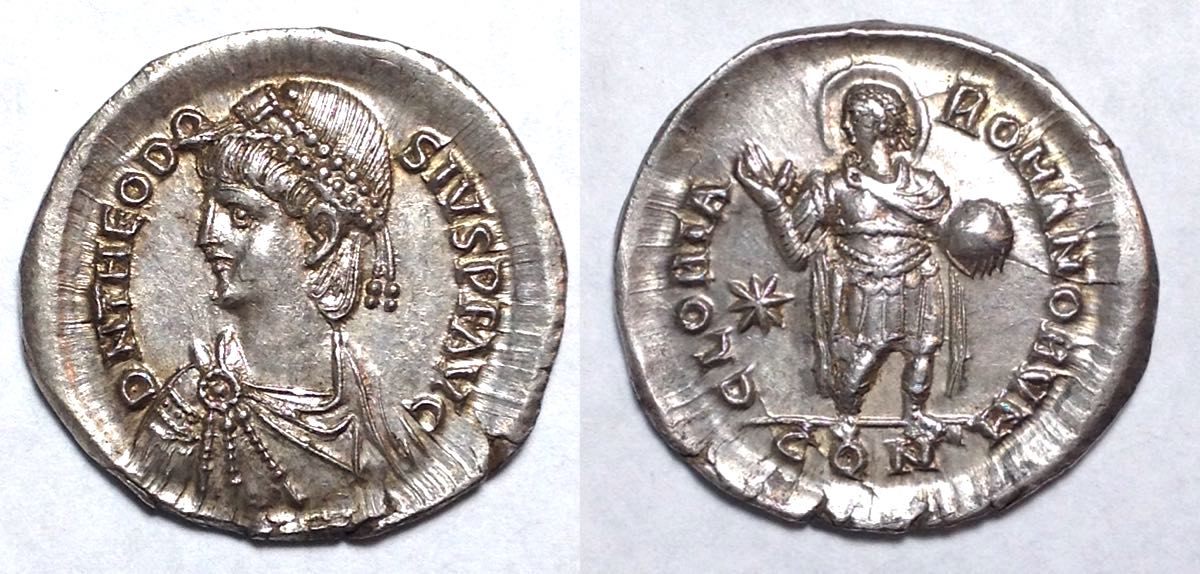 |
| Theodosius II, struck 438-450 |
Theodosius II, struck 402-408 [DOC] Miliarense. |
17 mm. 1.53 grams.
VOT/MVLT/XXXX
CONS✳ for Constantinople. RIC X Constantinople 389 |
23 mm. 4.28 grams.
GLORIA ROMANORVM
CON RIC X 370 (Constantinople) "408-c. 420" |
Siliqua in Britain. Late Roman silver is relatively scarce compared to copper and gold. For some reason, most extant siliquae were found in Britain. "With very few exceptions, hoards of silver miliarenses and siliquae are only found in two parts of the empire: Britainia and Romania. This is particularly surprising since these coins were struck at mints all over the empire and hoards of gold coins of this period have been discovered all over the empire." (Bland and Johns, p. 16) They are usually mintmarked from the western mints Trier, Lugdunum, Arles, and Milan. There was no mint in Britain except the London mint (with mintmark "AVG") for a short time, 383-388, under Magnus Maximus. Nevertheless, most siliquae seem to have ended up in Britain.
Magnus Maximus (383-388) was a usurper who began in Britain and expanded his territory to include Spain and Gaul and some of Italy during the time of Theodosius (379-395). His copper and gold, like you might expect of a usurper, seem relatively scarce compared to other emperors of the time. But, he issued siliqua which are so numerous they seem to carry no premium over siliqua of other rulers. They were issued with a lighter weight standard--c. 1.6 grams.
Siliquae of Magnus Maximus, 383-388, usurper from Britain
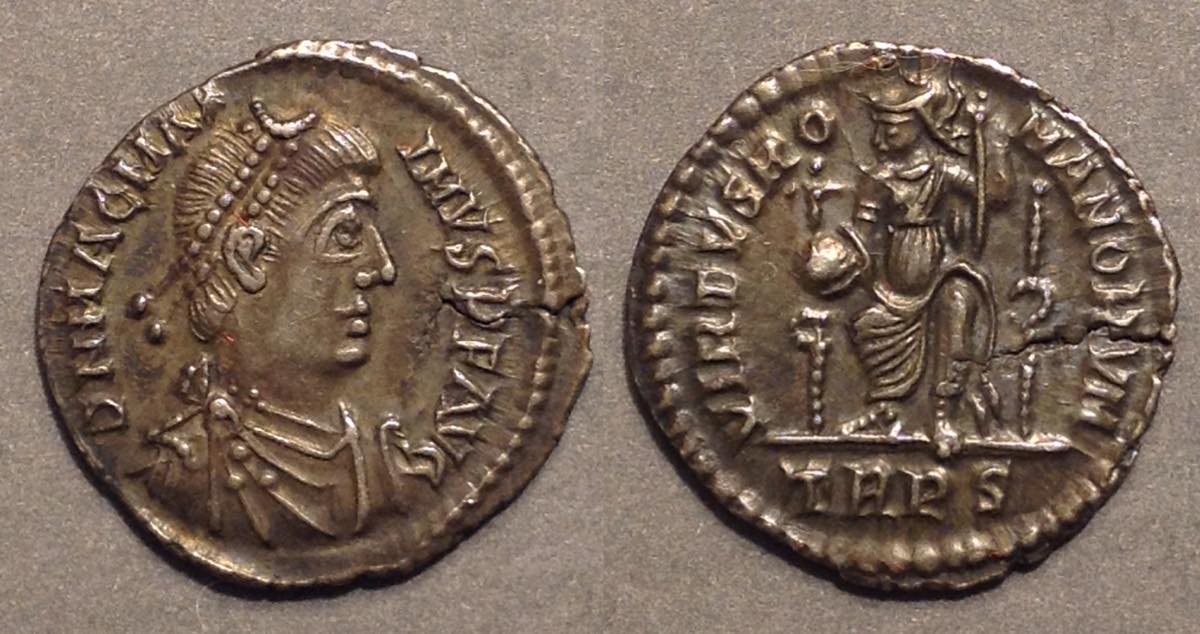 |
 |
| Magnus Maximus, struck 383-388 |
Magnus Maximus, struck 387-388 |
17 mm. 1.56 grams. Siliqua.
VIRTVS ROMANORVM
TRPS for Trier. RIC Trier 84c. |
17 mm. 1.50 grams. Siliqua.
VIRTVS ROMANORVM
MDPS for Mediolanum = Milan. RIC Mediolanum 19a. |
Responsibility for Britain was abandoned by the central empire in 410. Numerous hoards have been found with closing dates that are after that, even as much as 30 years after, although they are difficult to date because they do not contain later coins. But, when a hoard's issues from close to 410 show substantial wear, we infer the hoard closed much later than 410.
Coins of other silver denominations. From the second century BC through the second century AD there was only one significant silver denomination, the denarius. It is very common and we know what it was worth in terms of the copper and gold denominations. The only other silver denomination, the quinarius (worth half a denarius), was seldom issued and played little role in the coinage. So, for four centuries the silver coinage was simple to understand.
In contrast, silver coins from the fourth century are relatively scarce and there are often three or more silver denominations in use at the same time, without being obvious multiples of one another. They must have been valued according to their silver content. How they relate to the copper and gold denominations is uncertain.
Late Roman hoards with silver coins often include several denominations. For example, the famous large Hoxne hoard had over 15,000 late Roman silver coins including light milirensia, heavy siliquae, reduced siliquae (almost all of which were clipped to a greater or lesser extent), and a few half siliquae. The coins must have been valued by weight.
Constantine (307-337) and Constans (337-350)
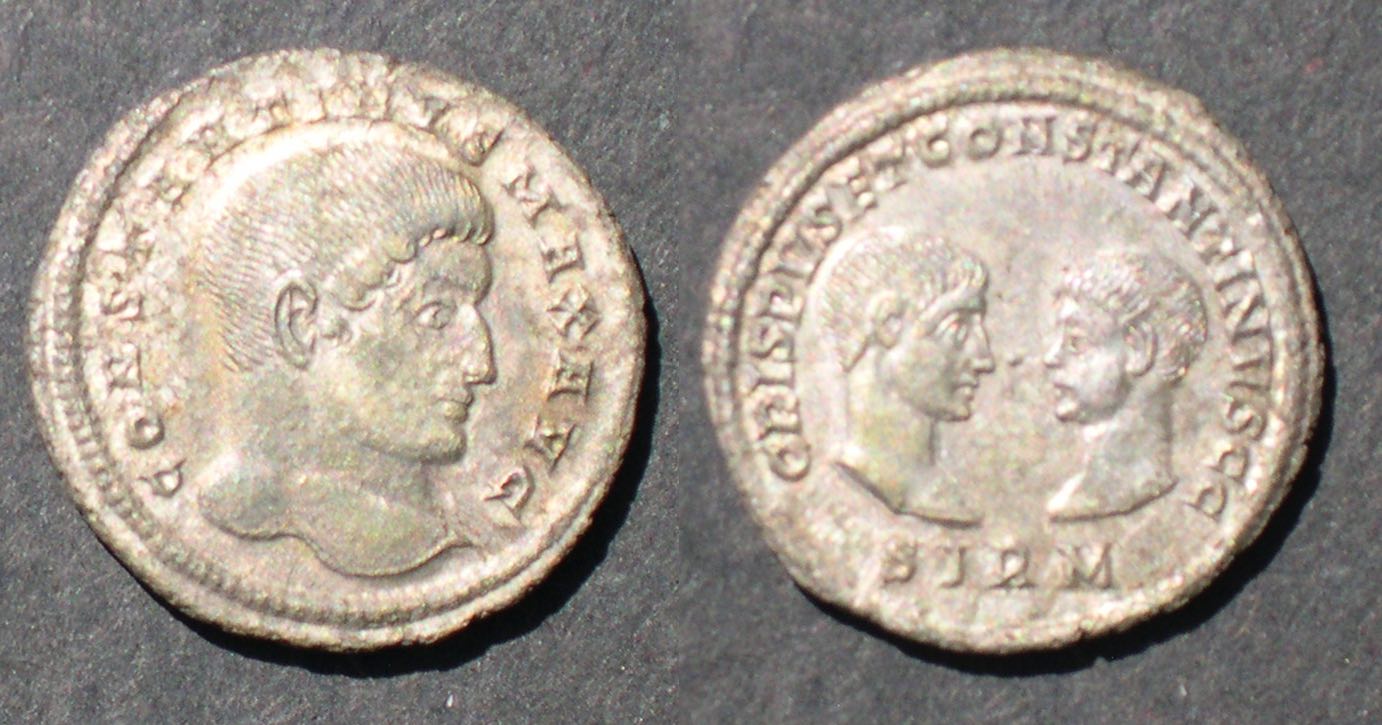 |
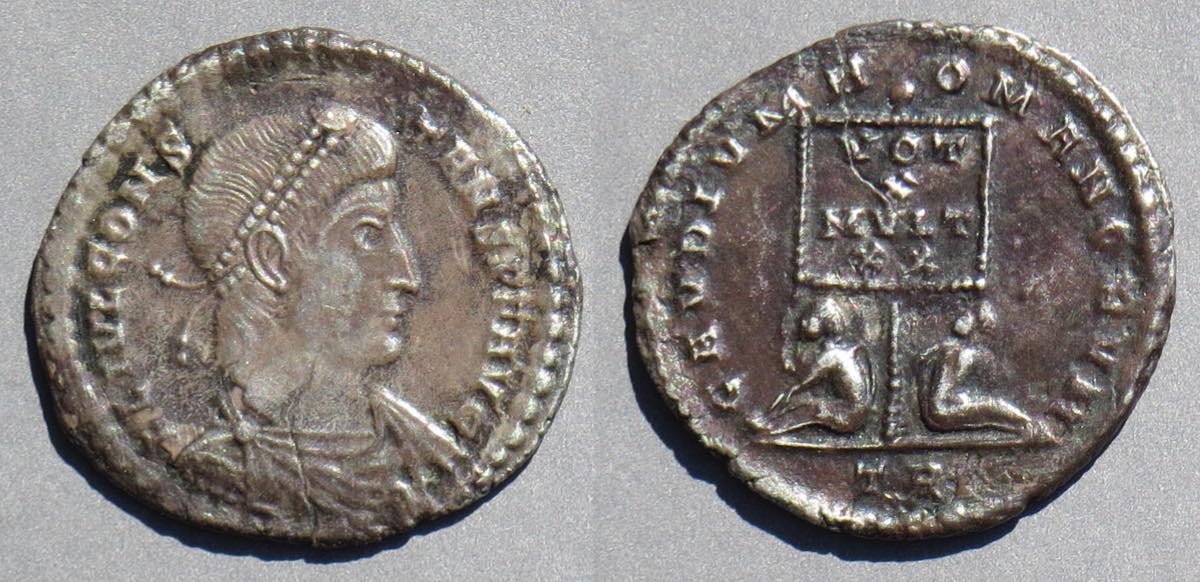 |
| Constantine, 307-337 "small medallion" [RIC] Struck 320-324. |
Constans as Augustus, 337-350 "Light miliarense" |
22 mm. 4.31 grams.
CONSTANTINVS MAX AVG
Crispus and Constantine II face to face
CRISPVS ET CONSTANTINVS CC
SIRM RIC VII Sirmium 14 |
23-22 mm. 4.16 grams. A light miliarense.
FL IVL CONSTANS PF AVG
GAVDIVM ROMANORVM around standard and two seated captives, VOT/X/MVLT/XX on banner
TR in exerge. RIC VIII Trier 159 |
Valens, 364-378, and Gratian (402-450). Miliarense.
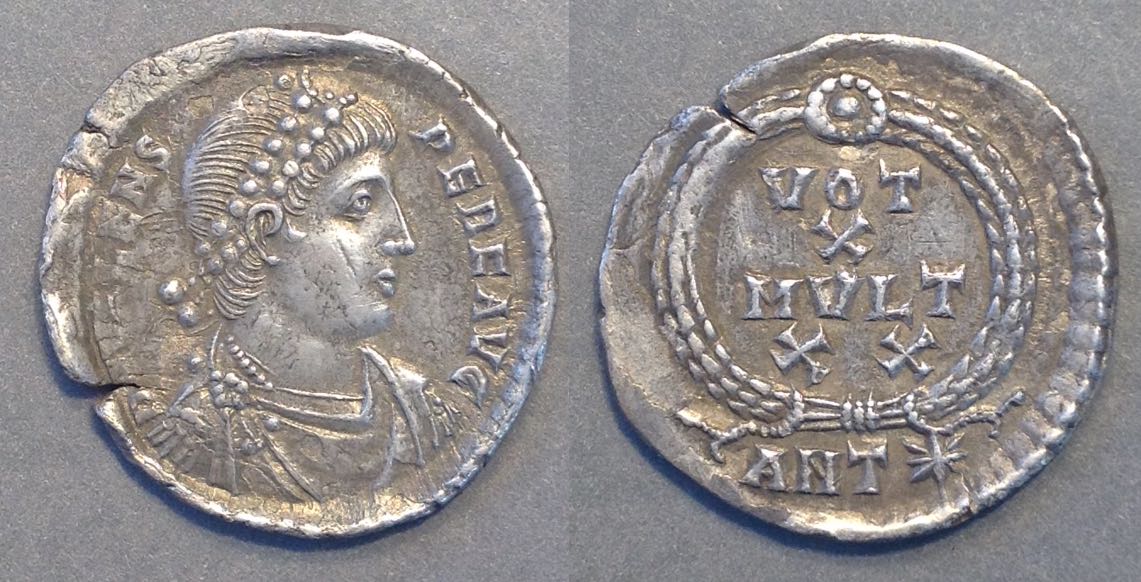 |
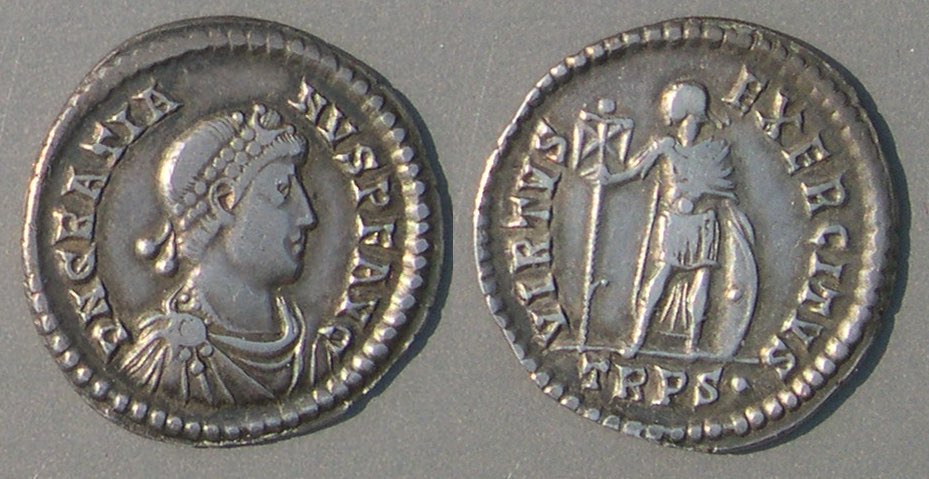 |
| Valens, struck 367-375 [RIC] "Heavy miliarense" |
Gratian, struck 367-375. A "light miliarense" |
|
4.89 grams. 23 mm. Thicker.
DN VALENS PERF AVG
VOT X MVLT XX in wreath
ANT✳ RIC IX Antioch 28.
|
24 mm. 4.34 grams. Thinner, but not thin.
DN GRATIANVS PF AVG
VIRTVS EXERCITVS
TRPS• in exergue. RIC IX Trier 26e |
Value. The "reduced" siliqua was usually 1.9-2.2 grams. The "light miliarense" was less common and often near 4.2 grams. Maybe it was a 2-siliqua piece. The "heavy miliarense" was typically 4.8 to 5.2 grams. How does that fit in with the siliqua? Is it some number to a solidus? Some authors say the heavy miliarense was 14 to a solidus and the light one 18 to a solidus. If the silver:gold ratio were 12:1 as is explicit in Diocletian's Edict, 14 heavy miliarense of 5 grams of silver each would make 70 grams of silver which would be worth 70/12 = 5.83 grams of gold. That is too much. It should be 4.45 grams, the weight of a solidus, or less. The relative values of the denominations are uncertain.
We call the coins siliquae but we do not have clear evidence that the ancient Romans called them that. Also, we do not have clear ancient evidence of what they were worth in terms of solidi or copper coins. The word siliqua refers to a carob seed (siliqua graeca) from which our term "carat" comes--as in "24-carat gold." The carob seed consistently weighs c. 0.185 grams and the weight of 24 of them makes the weight of a gold solidus (c. 4.45 grams). If a coin were intended to be worth 1-carat of gold, it would be worth 0.185 grams of gold. Diocletian's Edict of Maximum Prices has the gold:silver ratio of 12:1; It could have changed since then, but probably not much. So, it would be worth about 12 times 0.185 grams = 2.22 grams of silver. That is just right for reduced siliquae, but not for earlier coins. It is hard to tell when our term "siliqua" was in ancient use and what coins it refered to. Maybe it refers to coins after the reform of 355 which introduced what we call a "reduced" siliqua. It will require more research and some scholarly luck to find a dated reference to the word siliqua.
Advice for collectors: Pay attention to weights. Many siliquae are clipped and that is a serious negative.
Many siliquae have flan cracks. They are a serious negative but so many siliquae have flan cracks that they are hard to avoid.
Be careful handling them; they are thin and some have weak, crystalized, metal, and many have flan cracks which makes breaking them a distinct possibility. (Witness the Procopius below that had part of the rim break off after it was sold to Bunker Hunt.)
Conclusion. In the second half of the fourth century the siliqua is the most frequently encountered silver denomination. Larger "heavy" and "light" miliarensis-denominations were also issued.
The end of the introduction.
You may quit here, or you may continue with many more images below.
of Constans, Constantius II, Constantius Gallus, Julian II, Jovian, Valentinian, Valens, Gratian, Valentinian II, and Theodosius
or, leave this page and go to the main Table of Contents for this educational site.
Skip down to the references below.
More images.
Constans (Caesar 333-337 and Augustus 337-340). Siliqua do not become common until after the death of Constantine when his sons became Augusti.
Constans, as Augustus 337-350
 |
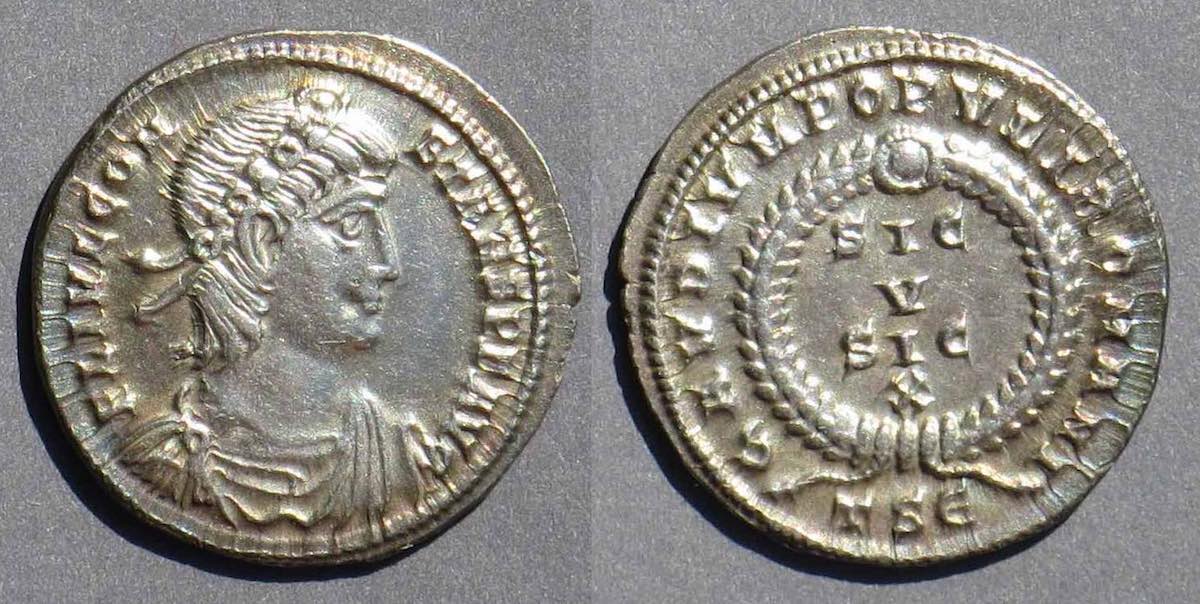 |
| Constans, struck 340-350 |
Constans, Struck 337-340 |
|
19 mm. 3.08 grams. (Heavy) siliqua.
FL IVL CONSTANS PF AVG
VICTORIA AVGUSTORVM
SISc in exergue. RIC VIII Siscia 167
|
20 mm. 3.18 grams. (Heavy) siliqua.
FL IVL CONSTANS PF AVG
GAVDIVM POPVLI ROMANI around
SIC/V/SIC/X in wreath.
TSE in exergue. RIC VIII Thessalonica 42 |
Comment for Collectors. The heavy siliqua on the left above has a long flan crack from 6:00 upwards. So does the the siliqua on the left in the next table. Flan cracks are common on siliquae and should be taken into account when valuing the coin.
Constantius II (Caesar 324-337 and Augustus 337-361).
Constantius as Augustus, heavy siliquae
 |
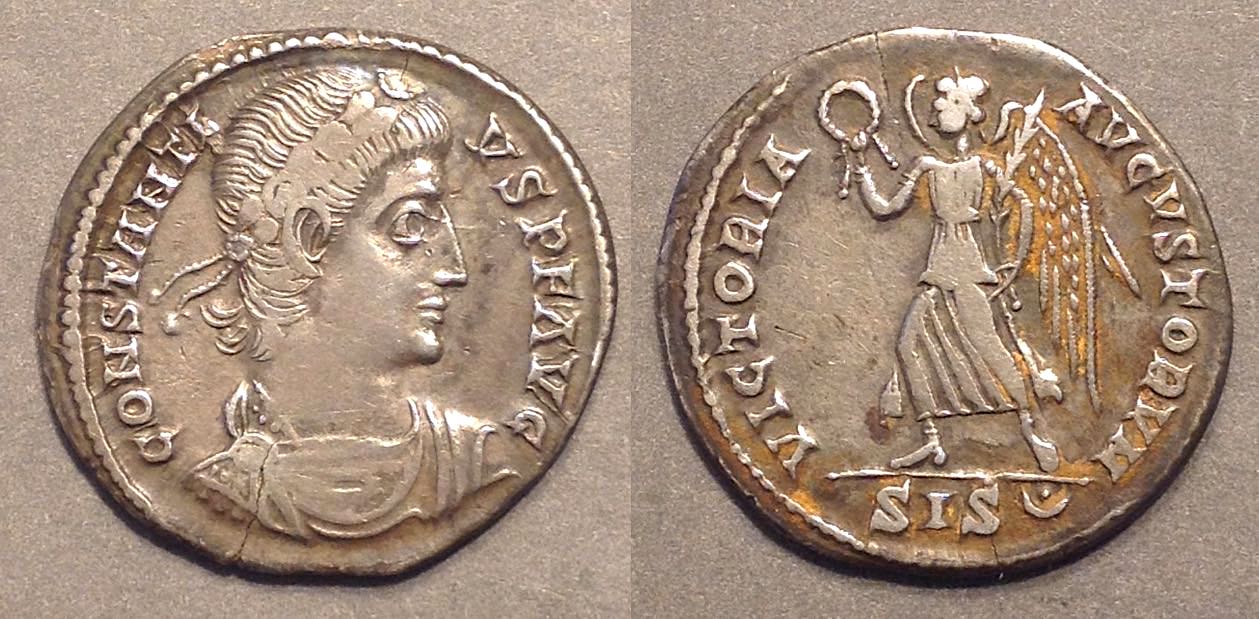 |
| Constantius II, struck 337-340 |
Constantius II, struck 340-350 |
20 mm. 3.05 grams. Siliqua.
CONSTANTIVS PF AVG
VICTORIA DD NN AVGG, Victory advancing left
TES in exergue. RIC Thessalonica 53 |
20 mm. 2.92 grams. Siliqua
CONSTANTIVS PF AVG
VICTORIA AVGVSTORVM
SIS with dotted crescent in exergue. RIC Siscia 162 |
Constantius II, siliqua, VOTA types
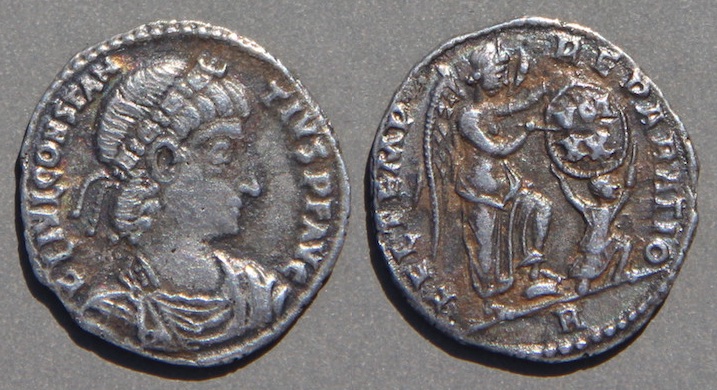 |
 |
| Constantius II, struck c. 347 |
Constantius II, struck 340-March 351, |
20-19 mm. 2.96 grams. Siliqua.
FL IVL CONSTANTIVS PF AVG
FEL TEMP REPARATIO (a legend very common on copper)
Victory standing right
inscribing VOT/XX on shield held up by a captive
R in exergue. RIC Rome 59 |
20 mm. 2.78 grams. Siliqua.
Obverse anepigraphic
FELICITAS REIPVBLICA around wreath,
VOT/XX/MVLY/XXX within
SMN in exergue. RIC Nicomedia 39 |
Constantius II, siliqua
 |
 |
| Constantius II, struck 340-351. |
Constantius II, struck late 347-6 Nov. 355. |
19 mm. 2.22 grams.
DN CONSTANTIVS AVG
FELICITAS REIPVBLICE around wreath
VOT XV MVLT XX within
C•A in exergue (very weak). RIC Constantinople 451. |
21 mm. 3.01 grams
(holed and plugged to the left of the "A" in "ANT")
DN CONSTANTIVS PF AVG
VOTIS/XXV/MVLTIS/XXX in wreath.
ANT in exergue. RIC Antioch 106. |
The VOT XV coin above shows that lighter siliqua were already being issued before the "reduced" siliqua after 355.
The next type with vows for 30 years multiplied to 40 years is the most common (The first two coins on the page were also this type).
Constantius II, reduced siliqua
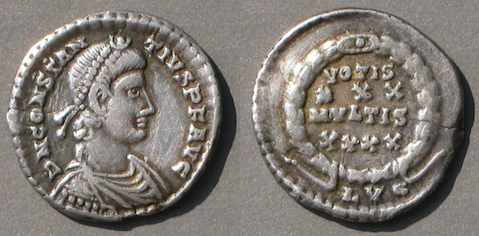 |
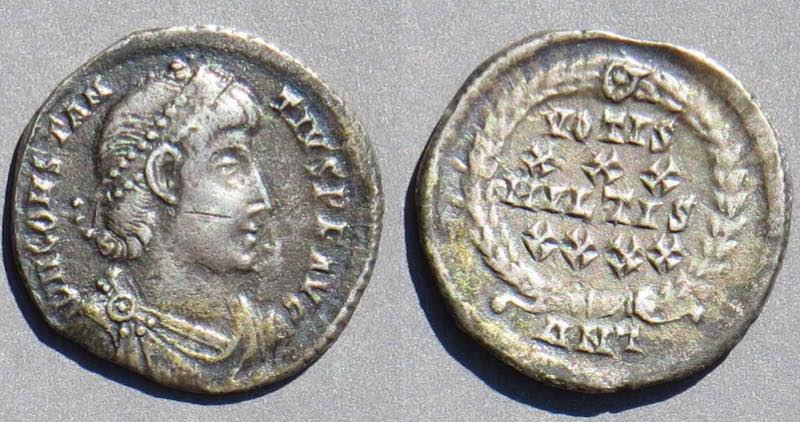 |
| Constantius II, struck 360-363 |
Constantius II, struck 355-361. |
17 mm. 2.32 grams. Reduced siliqua
DN CONSTANTIVS PF AVG
VOTIS/XXX/MVLTIS/XXXX in wreath
LVG in exergue. RIC Lugdunum (Lyons) 216 |
18 mm. 1.78 grams. Reduced siliqua
DN CONSTANTIVS PF AVG
VOTIS/XXX/MVLTIS/XXXX in wreath
ANT in exergue. RIC Antioch 186 |
Siliquae of Constantius Gallus are much less common.
Constantius Gallus, 351-354
 |
| Constantius Gallus, struck 351-354, A heavy siliqua, pre-reform. |
20-19 mm. 2.98 grams. Heavy siliqua.
DN CONSTANTIVS NOB CAES
VO/TIS/V in wreath
ANT in exergue. RIC Antioch 109 |
Siliquae of Julian II are common. They can weigh up to 2.2 grams, but many--even those not obviously clipped--weigh down to about 1.7 grams.
Julian II, siliquae from Lugdunum
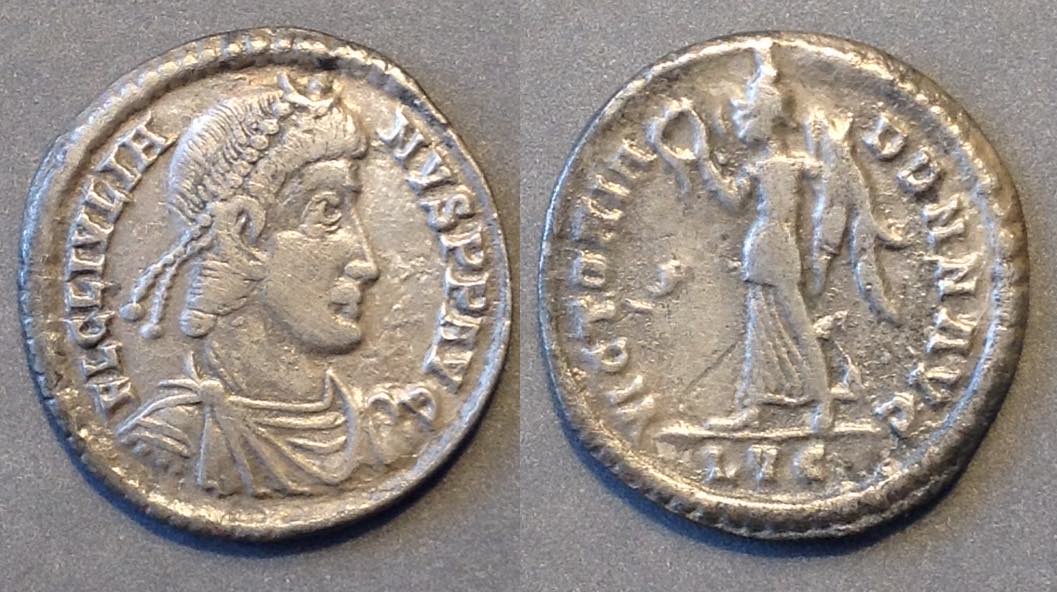 |
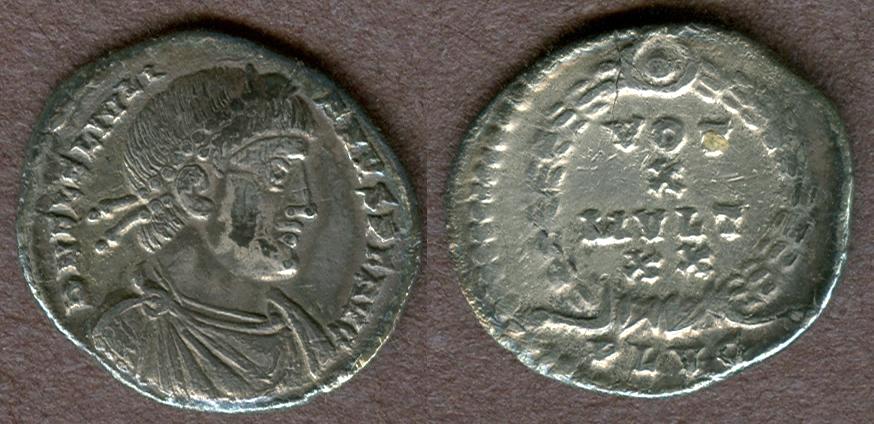 |
| Julian II, struck 360-363 |
Julian II, struck 360-363. |
|
17 mm. 1.76 grams.
FL CL IVLIANVS PF AVG
VICTORIA DD NN AVG, Victory advancing left
LVG in exergue. RIC Lyons 213.
In 2016 the ticket said,
"Found 20 miles east of York a couple of years ago"
|
18-15 mm. 1.85 grams.
DN FL CL IVLIANVS PF AVG
VOT/X/MVLT/XX in wreath.
PLVG in exergue. RIC Lyons 234. |
Many siliquae of Julian II mention vows.
Julian II, reduced siliquae with vows
 |
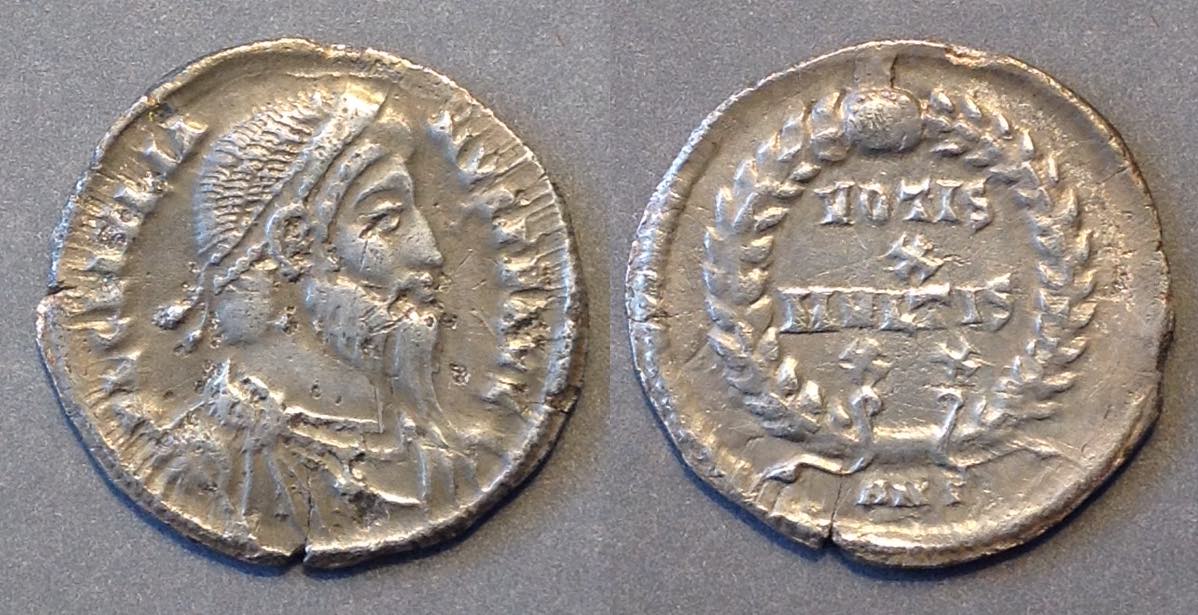 |
| Julian II, struck Spring 360- 26 June 363 |
Julian II, struck Nov. 361- 26 June 363 |
|
18-17 mm. 1.80 grams.
DN CL IVLIANVS AVG
VOTIS/V/MVLTIS/X in wreath
TCON in exergue. RIC Arelate 297.
|
19-18 mm. 1.95 grams.
FL CL IVLIANVS PF AVG
VOTIS/X/MVLTIS/XX
ANT in exergue. RIC Antioch 212. |
Jovian took the throne when Julian II was killed in 363 while fighting the Sasanians.
Jovian, 363-364, reduced siliqua with vows
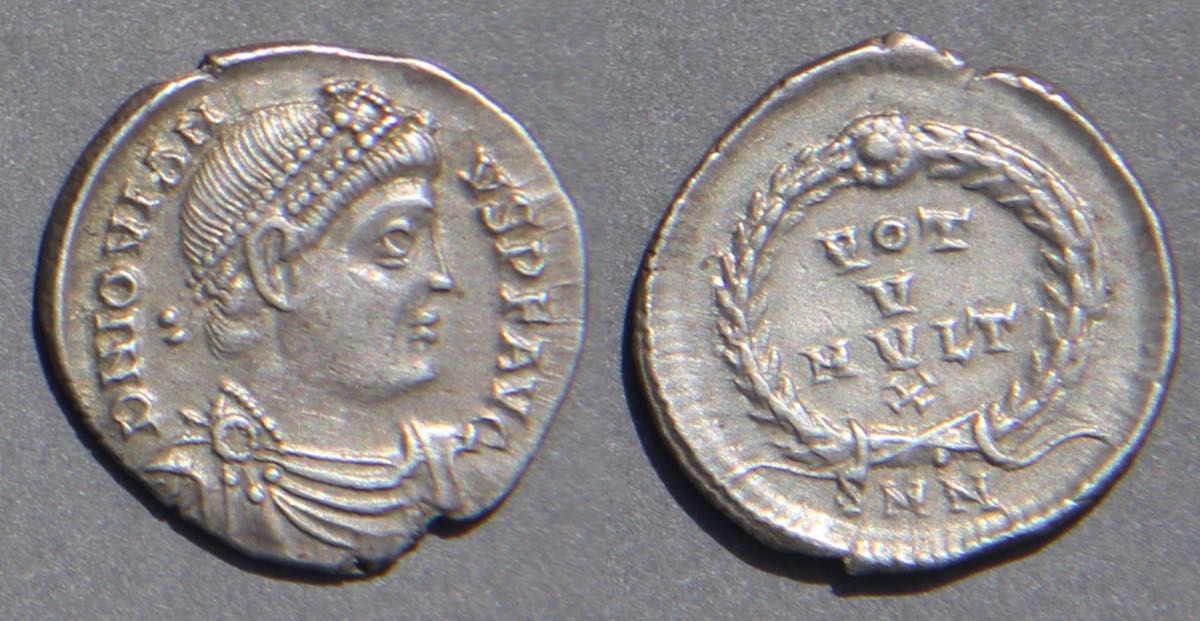 |
| Jovian, struck 27 June 363 - 16 Feb. 264 |
18 mm. 2.26 grams.
DN IOVIANVS PF AVG
VOT/V/MVLT/X in wreath
SMN in exergue. RIC Nicomedia 127 |
Valentinian, 364-375, and Valens, 364-378. Jovian was succeeded by Valentinian in 364 who soon elevated his brother Valens to co-Augustus.
Valentinian (364-375) and Valens (364-378) siliquae from Rome
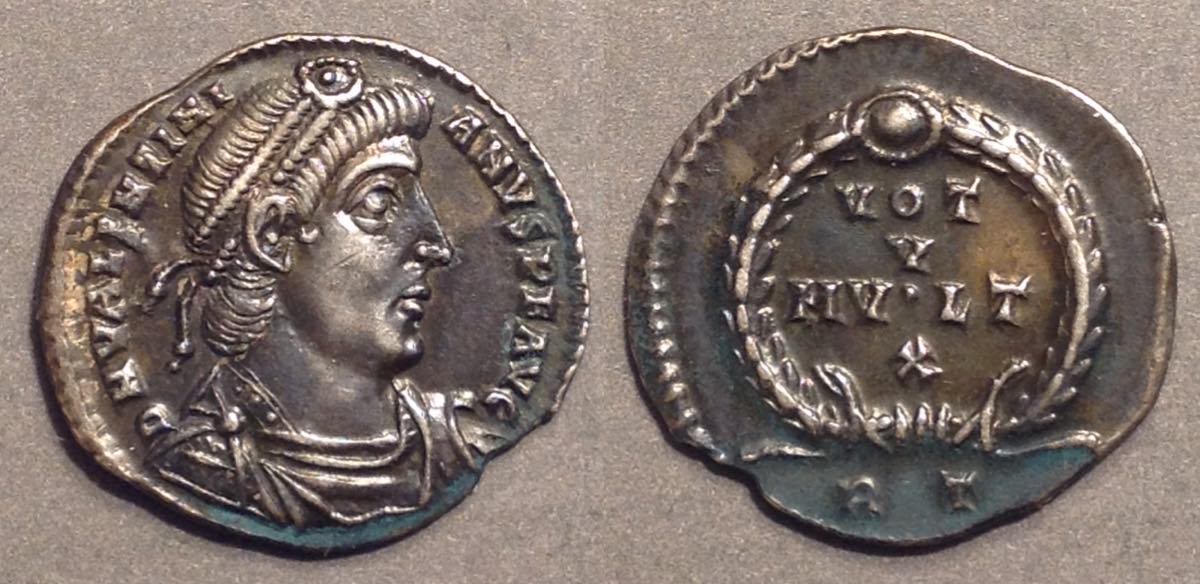 |
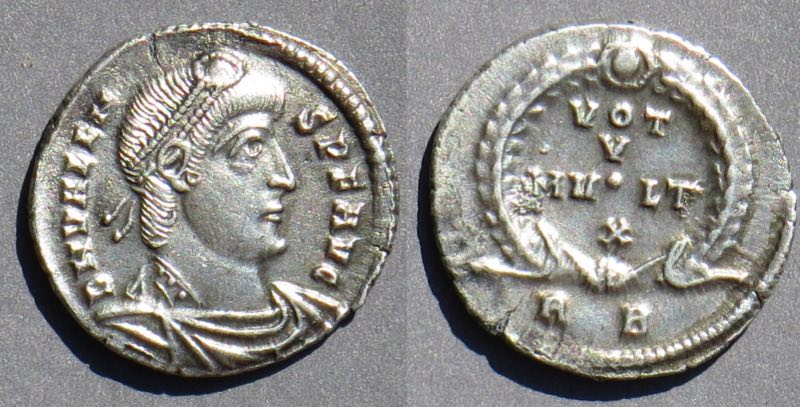 |
| Valentinian, struck 25 Feb. 364 - 24 Aug. 367 |
Valens, struck 25 Feb. 364 - 24 Aug. 367 |
18-17 mm. 2.09 grams.
DN VALENTINIANVS PF AVG
VOT/V/MVLT/X in wreath
R T in exergue. RIC Rome 10a2. |
18 mm. 2.14 grams.
DN VALENS PF AVG
VOT/V/MVLT X in wreath
R B in exergue. RIC Rome 10d. |
Valens (364-378) siliquae from Antioch
 |
 |
| Valens, struck 367-375. |
Valens, struck 375-378. |
19 mm. 2.08 grams.
DN VALENS PERF AVG
VOT/X/MVL/XX in wreath
ANT in exergue. RIC Antioch 33c. |
19-17 mm. 2.08 grams.
DN VALENS PF AVG
VOT/XX/MVLT/XXX in wreath
CNCM in exergue. RIC Constantinople 42(bis) |
Valens, 364-378. Base metal.
 |
| Valens. Counterfeit in AE. Prototype 367-375. |
18-17 mm. 1.57 grams. (Light for a siliqua)
DN VALENS PF AVG
VOT/V/MVLT/X in wreath
SMN in exergue. RIC IX Nicomedia 20b is the prototype. |
Procopius, 365-366
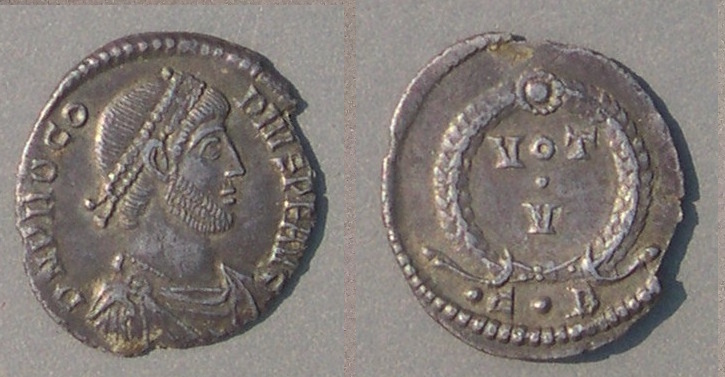 |
| Procopius, struck 365-366. Siliqua. |
18-17 mm. 1.69 grams. Rim broken off from 2:00 to 6:30.
DN PROCOPIVS PF AVG
VOT/V in wreath
•C • B in exergue. RIC Constantinople 13e2. |
The above Procopius siliqua has an interesting pedigree. It was offered in NFA I, March 1975, the sale of the collection of the Santa Barbara Museum of Fine Art. The photo shows the rim was already broken off from 3:00 to 6:30 at that time, but the rim from 2:00 to 3:00, now broken off, was still there. Then it appeared in the Nelson Bunker Hunt Sotheby's sale IV, June, 1991, where it was broken as seen above. The lesson is that siliquae can be fragile! Be careful with them! The buyer immediately attempted to sell it for twice the price in a fixed-price catalog. I don't think that worked. Anyway, it later sold in 2006 for approximately the Bunker Hunt price.
Gratian, the elder son of Valentinian, was made Augustus in 367 even though he was only seven years old. Several denominations were issued in his name including the heavy miliarense (rare), the light miliarense (scarce), the siliqua (common), and other denominations which are very rare including the half siliqua, the argenteus, and the half argenteus.
Gratian, 367-383. Siliquae
 |
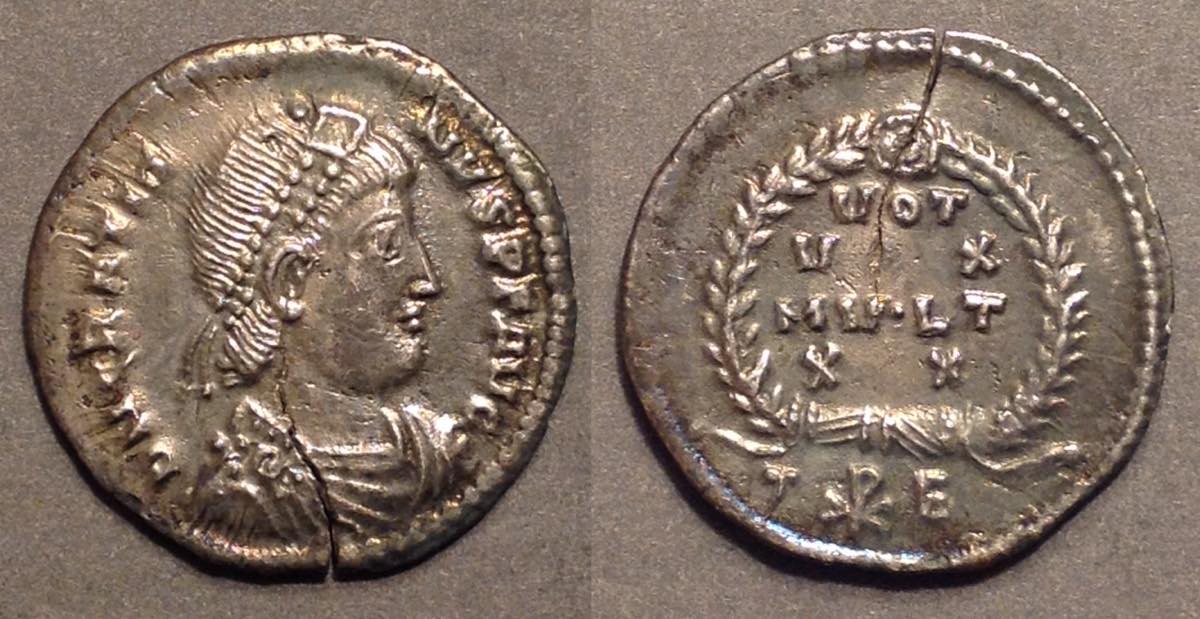 |
| Gratian, struck 375-378. Siliqua |
Gratian, struck 375-378. Siliqua |
18 mm. 1.94 grams.
DN GRATIANVS PF AVG
VOT/XV/MVLT/XX in wreath
SISCPS in exergue. RIC Siscia 19b |
18 mm. 1.81 grams.
DN GRATIANVS PF AVG
VOT/VX/MVLT/XX [sic] in wreath
T<chi-rho>E. RIC Thessalonica 30b |
Gratian, 367-383
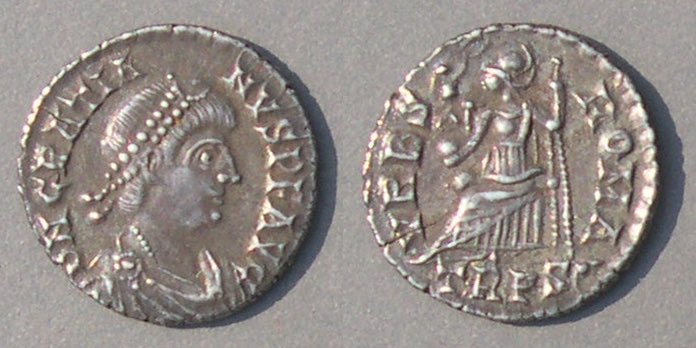 |
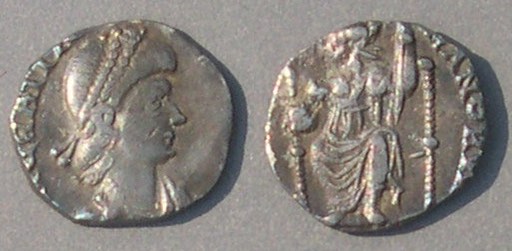 |
| Gratian, struck 367-375 |
Gratian. Struck 382-383.
Severely clipped later. |
17 mm. 2.26 grams. (Full weight, despite its small diameter)
DN GRATIANVS PF AVG
VRBS ROMA, Roma seated left, holding Victory on globe
TRPS in exergue. RIC IX Trier 27f |
Now 12 mm and 0.95 grams.
VIRTVS ROMANORVM
Roma seated holding globe and scepter
Mint mark clipped off the flan. |
Valentinian II (375-392) and Theodosius (379-395). Valentinian II, the younger son of Valentinian (and half brother of Gratian), was made co-Augustus in 375 at age four! Gratian and Valentinian II were only eight and seven when Valens was killed at the Battle of Adrianople in 378, so the need for an established military man was evident. The general Theodosius was made Augustus by Gratian in 379.
Valentinian II, 375-392, and Theodosius, 379-395
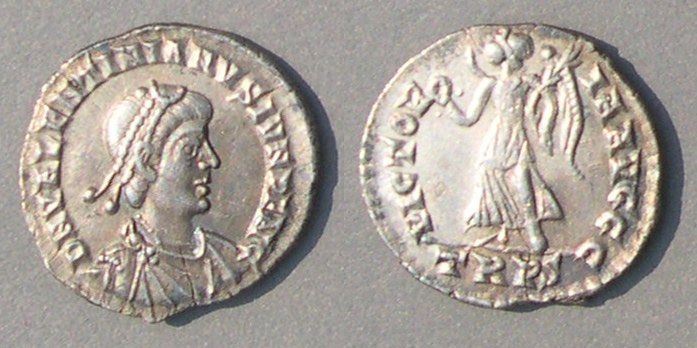 |
 |
| Valentinian II, struck 378-383. Siliqua. |
Theodosius, struck 378-383. Siliqua |
17 mm. 2.16 grams.
DN VALENTINIANVS IVN PF AVG ("IVN" for "Junior")
VICTORIA AVGGG
TRPS in exergue. RIC Trier 43. |
17 mm. 1.92 grams.
DN THEODOSIVS PF AVG
VOT/V/MVLT/X
SISCP<backwards Z> in exergue. RIC Siscia 24b.
|
Theodosius, 379-395. Siliquae
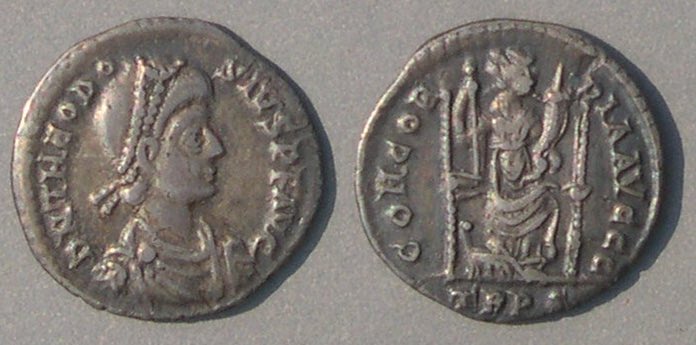 |
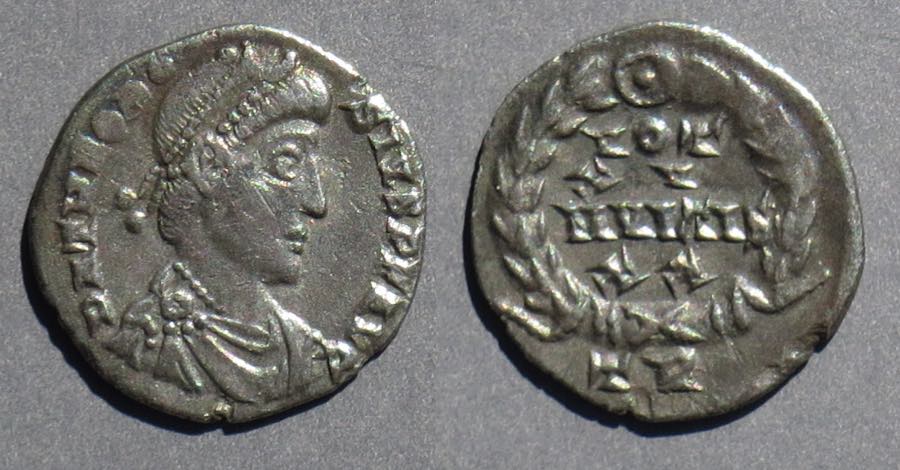 |
| Theodosius, struck 378-383. Siliqua. |
Theodosius, struck 379-383. Clipped siliqua. |
17 mm. 1.89 grams.
DN THEODOSIVS PF AVG
CONCORDIA AVGGG
TRP• in exergue. RIC Trier 55a. |
15 mm. 1.19 grams. Clipped.
DN THEODOSIVS PF AVG
VOT/XV/MVLT/XX
TR in exergue. RIC Trier --. RIC p. 26 has these vows for Gratian as RIC 62, "R5," with this mint mark, but it is not listed for Theodosius. It would be RIC Trier 62b. |
Arcadius, 383-408
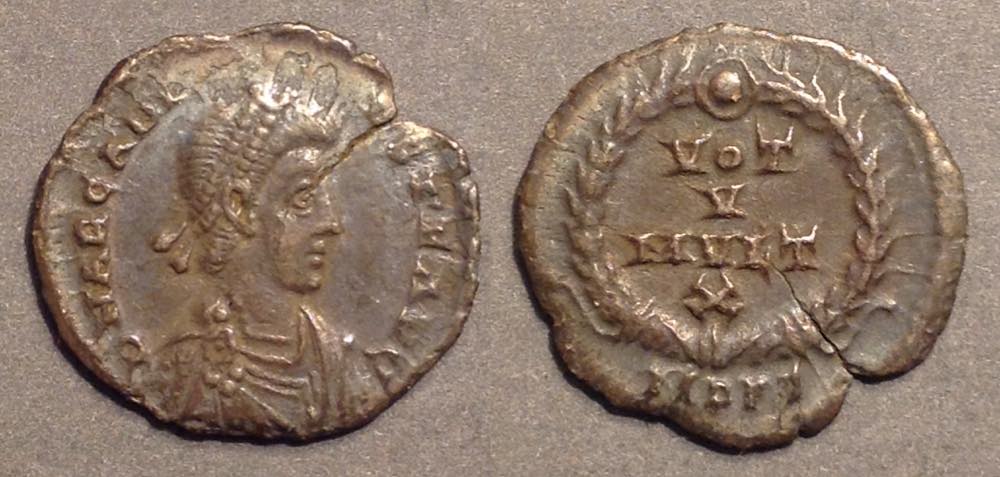 |
| Arcadius, struck 383-388. Siliqua |
17-16 mm. 1.43 grams.
DN ARCADIVS PF AVG
VOT/V/MVLT/X
MDPS in exergue. RIC Mediolanum 13. |
There are many more interesting silver types from the fourth and fifth centuries, but this page stops here.
The end.
References:
King, Cathy. Roman Silver Coins and their Values, volume V, Carausius to Romulus Augustus. 1987. A (very nearly) complete list of siliqua and all other silver types arranged by emperor and alphabetically within emperor, priced in VF and EF. The numbering system is taken over from Cohen. It begins with 73 pages of tables of types and mints with some discussion. Then there are 136 pages listing types and illustrating one to five coins per page.
RIC VII, VIII, IX, and X. Roman Imperial Coinage. RIC VIII covers the sons of Constantine through Jovian (337-363). RIC IX covers Valentinian through Theodosius (364-395).
Bellinger, A. R., Bruun, Kent, and Sutherland. "Late Roman gold and silver coins at Dumbarton Oaks: Diocletian to Eugenius." Dumbarton Oaks Papers, 1964, page 163 to 236 plus 306 silver and gold coins on plates. 72 pages of coin descriptions. Little commentary.
Bland, Roger, and Catherine Johns. The Hoxne Treasure: An Illustrated Introduction. 1993. A short (32 pages), well-illustrated, summary of the treasure.
Casey, P. J. "Magnus Maximus in Britain." in The End of Roman Britain, ed. P. J. Casey, BAR British Series 71, 1979, pages 66-79 and plate 2.
Guest, Peter. The Late Roman Gold and Silver Coins from the Hoxne Treasure. I am quoting from his summary handout.
Grierson, Philip, and Melinda Mays. Catalogue of Late Roman Coins in the Dumbarton Oaks Collection and in the Whittemore Collection, from Arcadius and Honorius to the Accession of Anastasius. 1992. 346 pages plus 28 pages of an index plus 37 page plates of coins well photographed in black and white. Excellent and extensive commentary.
King, C. E. "A hoard of clipped siliquae in the Preston Museum," NC 1981, pages 40-64 and plates 13-20.
Naismith, Rory. Review in NC 2021, p. 555-557 of Argentum Romanorum sive Barbarorum ... (4.-6. Jh) edited by Jérémie Chameroy and Pierre-Marie Guihard. It is a book published in 2020 of articles about late Roman and early Byzantine silver.
Ball, Matthew. "Scratches on the 'Fleetwood' Hoard of Siliquae (RBCH 1553) at the Harris Museum, Preston" NC 2015, p. 171-194/\.
A Numis Forums discussion-board post about the similar silver denominations from around the time of Valens: https://www.numisforums.com/topic/4061-the-%E2%80%9Cargenteus%E2%80%9D-of-valens%E2%80%A6what-is-it/
Go to the main Table of Contents for this educational site.
This page first posted June, 2022.
 The siliqua Roman coin denomination in the fourth century AD.
The siliqua Roman coin denomination in the fourth century AD. 

















































